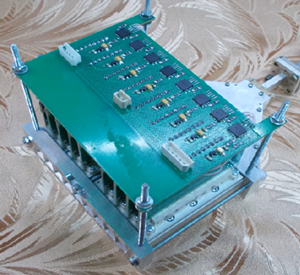Investigation and tuning procedure of Ka-band phased antenna array
DOI:
https://doi.org/10.3103/S0735272721090053Keywords:
phased antenna array, PAA, discrete and analog phase shifters, PS, nonidentity of phase characteristicsAbstract
The parameters of elements of the structural diagram of the Ka-band phased antenna array have been analyzed including the analog ferrite and discrete semiconductor phase shifters, control unit and the power distribution system.
A technique for tuning the array phasing elements is proposed, the use of which makes it possible to materially simplify and reduce the costs of their production. The effectiveness of the proposed tuning method has been tested experimentally using an example of 9-element linear phased antenna array that allows us to check an assumption about the nonidentity of phase characteristics of elements in antenna channels and their impact on parameters of the radiation pattern (RP). The tuning technique also takes into account the impact of electric characteristics of the aerial fairing or airborne radome, if present.
The essence of the technique implies that all radiating elements of antenna, except the central channel, where a phase shifter is not present, are covered with radio absorbing material. Next, the radiation pattern maximum is oriented in the direction of the radiating element located in the far zone by selecting the type and value of control signals. The determined control signal is stored in memory. Next, by opening the apertures of other radiator elements and tuning them one by one, we obtain a control signal matrix for the specified scanning sector. Thus, the phase shifter control matrix is formed, and additional computing devices are not needed during scanning. As a result of conducted experimental investigations based on an example of 9-element linear phased antenna array and using the proposed technique, it has been shown that the lack of identity of parameters of microwave elements does not affect in any way the speed and accuracy of the phase distribution formed in the antenna aperture.
References
- R. C. Hansen, Phased Array Antennas, 2nd ed. Wiley, 2009, uri: https://www.wiley.com/en-ag/Phased+Array+Antennas,+2nd+Edition-p-9780470401026.
- D. I. Voskresenskii, V. L. Gostyukhin, V. M. Maksimov, L. I. Ponomarev, Microwave Devices and Antennas, [in Russian]. Moscow: Radiotekhnika, 2006.
- D. I. Voskresenskii, Microwave Devices and Antennas. Designing of Phased Antenna Arrays, [in Russian]. Moscow: Radiotekhnika, 2012.
- D. M. Sazonov, Antennas and Microwave Devices, [in Russian]. Moscow: Vysshaya Shkola, 1988.
- M. Skolnik, Radar Handbook. McGraw-Hill Education, 2008.
- Y. S. Shifrin, L. G. Kornienko, Phased Antenna Arrays. Tutorial, [in Russian]. Kharkov: VIRTA PVO, 1975.
- Y. S. Shifrin, Antennas. Textbook, [in Russian]. Kharkov: VIRTA PVO, 1976.
- A. Eydus, V. Anpilogov, “A non-equidistant antenna array with a low level of side lobes,” Tekhnologii i Sredstva Svyazi, no. 2, pp. 40–42, 2017, uri: http://lib.tssonline.ru/articles2/sputnik/neekvidistantnaya-antennaya-reshetka-s-nizkim-urovnem-bokovyh-lepestkov.
- V. F. Kravchenko, V. I. Lutsenko, Y. Luo, I. V. Popov, “Nonequidistant two-dimensional antenna arrays based on latin squares,” Физические основы приборостроения, vol. 7, no. 1, pp. 4–23, 2018, doi: https://doi.org/10.25210/jfop-1801-004023.
- F. I. Emel’chenkov, “Onboard non-equidistant phased antenna arrays with densely packaged phase shifters,” Antennas, no. 11, pp. 45–52, 2005.
- M. Shcherbakov et al., “Radiation property heterogeneous antenna array,” Appl. Radio Electron., vol. 17, no. 1,2, pp. 60–65, 2018.
- N. S. Boltovets, T. I. Golynnaya, V. A. Krivutsa, “Investigation of silicon high-voltage microwave PIN diodes at enhanced temperature,” Tekhnika i Prib. SVCh, no. 1, pp. 52–54, 2008.
- M. S. Boltovets, V. A. Kryvutsa, K. O. Lychman, “Packageless silicon microwave PIN diode,” UA Patent No. 30533, 2008.
- V. A. Krivutsa, V. V. Basanets, N. S. Boltovets, V. N. Ivanov, L. M. Suvorova, K. A. Lychman, “Silicon high-voltage switch microwave PIN chip diodes with breakdown voltage no less than 2000 V,” Tekhnika i Prib. SVCh, no. 1, pp. 16–18, 2010.
- O. G. Vendik, M. D. Parnes, Electrically Scanned Antennas. Introduction into Theory, [in Russian]. Moscow: Sov. Radio, 2001.
- O. N. Ferrite-Domen, “Materials. OJSC NII Ferrite-Domen Catalogue. Part 8.” www.domen.ru.
- A. A. Tolkachev, S. A. Topchiev, Radiolocation in Millimeter Wave Band. Dynamics of Radioelectronics-2, [in Russian]. Moscow: Tekhnosfera, 2008.
- A. N. Puzakov, N. P. Milevskii, G. K. Yakovlev, “Comparative evaluation and development potential of fast ferrite phase shifters,” Obz. po Elektron. Tekhnike. Ser. Elektron. SVCh, no. 16, p. 50, 1978.
- A. J. Simmons, “Millimeter wave systems - an overview,” in Wescon Tech. Papers, 1970.
- N. P. Milevskii, “Fast ferrite millimeter wave band phase shifters,” in Series: Microwave Electronics. Regional Conference Abstracts, 1983, pp. 59–60.
- Y. P. Bychkov, Y. B. Korchemkin, A. V. Majorov, “Twin-toroid phase shifters,” in Proc. of XXVIII Moscow International Conference on Antenna Theory and Technology, 1998, pp. 24–32.
- B. V. Bounkin, A. A. Lemansky, “Experience of development and industrial production of X-band passive phased antenna arrays,” in Proc. of the International Conference on Radar, 1994, pp. 20–24.
- W. E. Hord, F. J. Rosenbaum, C. R. Boyd, “Theory of the suppressed-rotation reciprocal ferrite phase shifter,” IEEE Trans. Microw. Theory Tech., vol. 16, no. 11, pp. 902–910, 1968, doi: https://doi.org/10.1109/TMTT.1968.1126825.
- M. D. Rubin, “A new electronic phase shifter (Correspondence),” IEEE Trans. Microw. Theory Tech., vol. 10, no. 1, pp. 92–92, 1962, doi: https://doi.org/10.1109/TMTT.1962.1125459.
- S. Maltsev, M. Shcherbakov, O. Voitovych, G. Veselovska-Maiboroda, S. Labazov, A. Linkova, “Technique for tuning a phased array antenna of airborne radars of small-sized aircrafts,” in 2020 IEEE Ukrainian Microwave Week (UkrMW), 2020, pp. 67–70, doi: https://doi.org/10.1109/UkrMW49653.2020.9252586.


